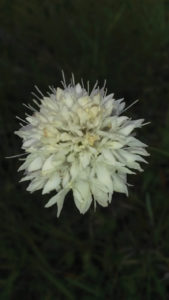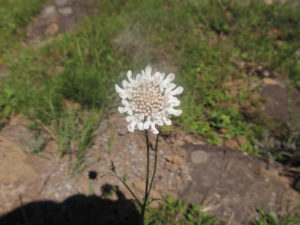Name: Scabiosa columbaria L.
Family: Dipsacaceae (Scabious family)
Common names:
Engl. Morning Bride, Perennial Scabious, Rice Flower, Scabious, Wild Scabiosa, Wild Scabious
Afr. Bitterbos, Jongmansknoop, Jonkmansknoop, Koringblom, Meerjarige Skurfkruid
Xho. Ilelemimoya, Isilawu Esikhulu, Iyeza lamehlo


Description
Tufted perennial herb up to 80cm when in flower. Leaves are hairy, variable, the lower ones are paddle-shaped and toothed or lobed, upper ones are deeply cut to the midrib into the slender lobes. Flower heads are about 30 mm in diameter, carried on long stalks, and the flowers vary from white to mauve-purple. Plants flower in spring and summer.
Conservation status
According to the SANBI (South African National Biodiversity Institute) Red list of South African Plants, Scabiosa columbaria was not selected in any one of four screening processes for highlighting potential taxa of conservation concern for detailed assessment and was hence given an automated status of Least Concern (LC). http://redlist.sanbi.org
Distribution and habitat
Perennial Scabious are often abundant in recently burned veld, especially Renosterveld, Waboomveld and Grassy Fynbos. This widespread species occurs through Africa, Europe and Asia. Provincial distribution: Eastern Cape, Free State, Gauteng, KwaZulu-Natal, Limpopo, Mpumalanga, Northern Cape and North West.
Derivation of name and historical aspects
Genus name comes from the Latin scabies meaning the itch in reference to the plant’s rough leaves which could possibly cure the itch. Columbaria is Latin meaning dove-like.
Ecology
Scabious flowers are nectar rich and attractive to many including butterflies and moth such as six-spot burnet. Species of Scabiosa are food plants for the larvae of some species of Lepidoptera such as the grey pug moth.
Uses and cultural aspects
The leaves or fleshly roots are used as a remedy for colic and heartburn. Some other traditional uses have also been recorded. Dried roasted roots are made into a wound-healing ointment, and the powdered roots are also used as a pleasant-smelling baby powder. The roots or leaves are either chewed fresh or taken in dried and powdered form, either directly or as a decoction.
Growing Scabiosa columbaria
This species it is easily grown in average, medium, well-drained soil in full sun. Regularly feed with slow-release 3:1:5 in spring and summer. Water moderately as this species can survive short periods of drought, but avoid over watering, as too much watering may cause the plant to die. Propagate from seed or cuttings. Sow in a warm temperature position at 18 to 12° C. Ensure that the soil is kept moist; germination takes place in two to three weeks after sowing. Seeds are harvested and collected in autumn; dry and store seed for the following spring season. Division and replanting is best done in spring and autumn. There are no known pests against these plants. Deadheading encourages prolonged flowering. Cut back dead branches to promote new shoots. http://pza.sanbi.org/scabiosa-columbaria
References and further reading
Van Wyk, B.E., van Oudtshoorn, B., Gericke, N. Medicinal Plants of South Africa. Briza Publications, Pretoria
Vlok, J, A. & Schutte-Vlok, A.L. 2010. Plants of the Klein Karoo. Umdaus Press, Hatfield, South Africa



